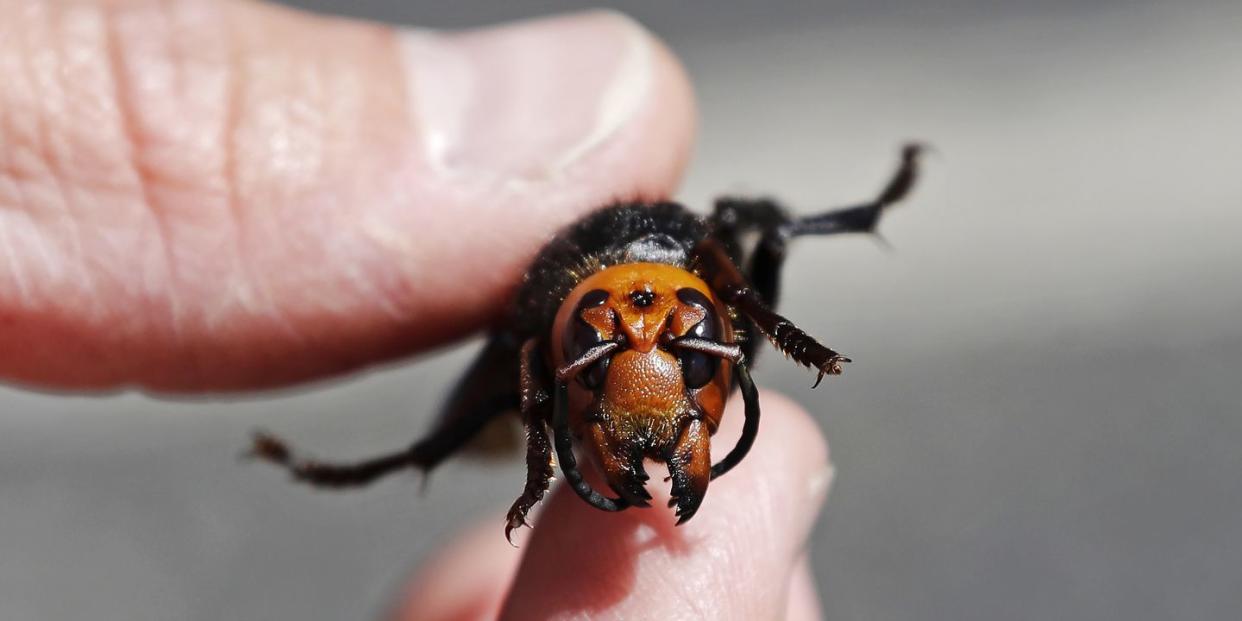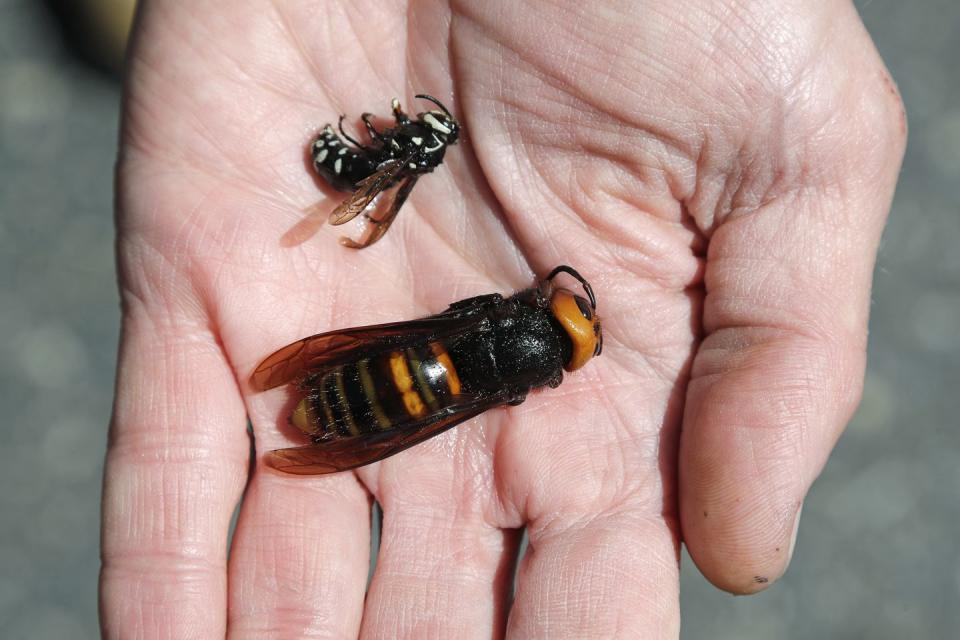Should You Be Worried About Murder Hornets? Here’s What to Know

The nickname alone is pretty menacing: murder hornet. Based on that moniker, you might assume these critters are out for blood—but that’s not the case.
Even though murder hornets—known as Asian giant hornets (Vespa mandarinia)—are typically more aggressive and larger than your average hornet (they can grow between 1.5 and 2 inches long), they don’t really deserve their bad rep.
You might be concerned about reports that V. mandarinia has been spotted in the U.S. for the first time, especially since they’re an invasive species and their presence could spell doom for native honey bees, so Popular Mechanics spoke to two experts—Katie Lee, Ph.D., a researcher studying bee health, and Matt Bertone, Ph.D., the director of the Plant Disease and Insect Clinic at North Carolina State University—to discover what all the buzz is about. Here’s what they had to say.
Where Are Murder Hornets From?
Murder hornets are native to Japan, but can also be found in other eastern Asian countries including Thailand, China, Nepal and even Russia. They are not, however, native to British Columbia or Washington state, where there have been confirmed (unrelated) sightings—a colony in Canada and two hornets in Blaine, Washington.
Scientists first spotted murder hornets in the Canadian city of Nanaimo in August 2019. Reported sightings helped beekeepers find the nest and destroy it using carbon dioxide, which displaces oxygen and essentially suffocates the hornet. Then, in December 2019, V. mandarinia was spotted in Washington state for the very first time.
So, how did they get here? According to Lee, one possibility includes the transportation of a queen via ship.
“There is really no way for the hornet to have arrived here without the help of humans,” Bertone says. “This probably happened accidentally, which very often is the case for invasive species, but there’s also a chance it was intentionally brought in.”
Still, Lee adds that it’s “not that uncommon for a species from another country to be introduced [to a new geographic area].” Lee said that an invasive species introduction doesn’t necessarily mean that the animals will be able to immediately form an established population. First, the murder hornets would have to acclimate to their new environment and, more likely than not, deal with the eradication from apiarists working to keep native bees safe.
Should You Be Worried About Murder Hornets?
On May 28, 2020, it was reported that a dead V. mandarinia specimen was found in Langley, British Columbia, while yet another dead specimen was also discovered in Custer, Washington—a city a mere 15 minutes away from Blaine, where the first U.S. specimen was found. According to The New York Times, “a photograph indicated that it was an Asian giant hornet, [per the Washington State Department of Agriculture], but researchers [are] planning to collect the specimen for further confirmation.”
Although murder hornets are making headlines for being found in new places, cause for concern should really be focused on native honey bees and what an influx of the invasive species could do to them.
The chance that you’ll encounter murder hornets stateside remains low. Lee said the chances of spotting them outside the areas they’ve already been seen in North America is even rarer. Bertone says the public shouldn’t worry too much, either.
“Unless [you] are either allergic to hornet stings or, in rare cases, someone stumbles upon a nest and is stung numerous times,” Bertone says. “In those cases the sheer amount of venom can cause severe medical issues.”
Here’s what to look for when identifying murder hornets: They are the world's largest hornets and have very little hair on their bodies, which are characterized by a “dark thorax, striped abdomen, and [an] orange face with black eyes,” per Lee. These hornets also have a pincer-like mandible used for decapitating other insects.

What About Honey Bees?
Honey bees have more to worry about when it comes to V. mandarinia than humans do. Bertone says if the invasive hornets managed to establish a home in the U.S., the results could be disastrous for native honey bees, which would also be bad news for agriculture and food supply since we need honey bees to pollinate plants and spread seeds.
“Asian giant hornets sometimes take over bee hives, killing all the adults and using the bee larvae as food for their own larvae,” Bertone says.
He says that some Asian honey bees—“a different species than [U.S.] honey bees”—have adapted to defend their hives against V. mandarinia by surrounding and essentially cooking the attacker using their body heat. Basically, Asian honey bees surround a hornet and flap their wings as hard and as fast as possible to raise the temperature within the swarm. Some of the honey bees closest to the hornet will also die from the increased heat, but so far, this is the best defense a bee colony has against V. mandarinia.
The way Japanese bees deal with murder hornets is just brutal but satisfying. pic.twitter.com/8zjUloVzPY
— Brandon Morse (@TheBrandonMorse) May 5, 2020
Unfortunately for U.S. honey bees, they have not developed this defense mechanism. In the rare event that murder hornets make a home in the U.S., beekeepers would likely step in to help protect native bees. Some of the things beekeepers are currently doing to preserve populations include planting bee gardens with plants that have high levels of nectar and pollen like hyacinths, echinacea, zinnias, and asters in addition to using chemical-free fertilizers and herbicides.
It remains unclear how murder hornets will affect the beekeeping industry, including honey production and pollination should they manage to establish a home base in the U.S. Lee says that our current concern for honey bees should focus on factors such as the loss of habitat and increased use of pesticides that bees have to contend with.
Protect Against Murder Hornets
Lee tells Popular Mechanics that while murder hornets “are more dangerous than other stinging insects [because] their large size allows them to deliver more venom,” it’s highly unlikely that a person in the U.S. would encounter a hornet and get stung.
Bertone also emphasized the “ample” amount of venom V. mandarinia can carry. National Geographic reports that all of the venom within the body of a hornet is “capable of killing about 10 mice.”
But these stings shouldn’t be significantly more dangerous to humans than the stings of other large wasps.” Although it’s not super common, every year people die from wasp and bee stings—in Japan it’s between 30 and 50 people—with the main cause of death being an allergic reaction and not the venom from the sting.
Bertone says that a lone wasp will typically go about its business and leave you alone if it’s not provoked. If you happen to come across a nest, the danger is greater.
Lee says that if you stumble upon V. mandarinia, the best thing to do is to put some distance between you and the hornet. If you’re stung, Bertone says to treat the site the same way you’d treat any other wasp or hornet: clean the area where you were stung, apply ice, take pain medication as needed, and be on the lookout for allergic reactions or infections.
You Might Also Like

